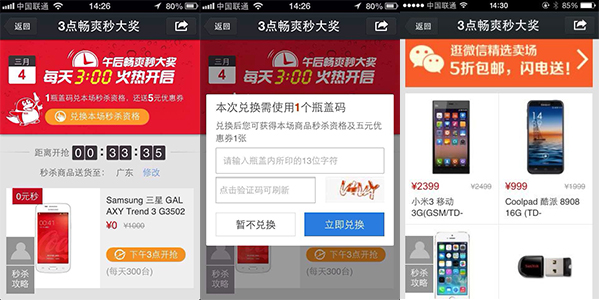
Do You still remember the “nickname bottle” that Coca Cola launched last summer? Such an impressive case was not so long ago, now Coca Cola has shifted its focus from bottle to cap, joining up with WeChat.
Caps are beverage manufacturers’ favorite widget for doing promotion, other than bottles. Such as the most popular “one more bottle” printed on caps in previous years, used to be a common promotion way for many manufacturers. As consumers get used to marketing strategies like “free taste”, “special sale” and “different bottle packaging”, beverage manufacturers are forced to search for new strategies.
Coca Cola tried some creative marketing activities for many years in China. They set up ICOKE platform in 2005, combining traditional marketing with internet platform. By holding iCoke events and communicating with young consumers, Coca Cola successfully built an online community and strengthened their brand awareness.
In the past year, Coca Cola launched a brand new packaging specially for Chinese young consumers. They printed dozens of internet nicknames on the bottle packaging, including popular nicknames such as “Chi huo” (meaning foodie), “Xiao qing xin” (people like indie pop) and “Bai fu mei” (white rich beautiful woman). By carrying out various marketing tactics, the nickname bottle won much attention and became a distinguishing brand marketing case in 2013.
Coca Cola, in cooperation with WeChat, launched a promotion activity named “3PM drink and win Coca Cola” on March 3 in 2014. The activity was jointly organized by Coca Cola, WeChat and Yixun. For getting the chance of “seckilling”, consumers just need to join the Coca Cola Interactive Platform on WeChat, and input the Pincode on the cap. Coca Cola prepared 990 million Coca Cola, Sprite and Fanta with WeChat logo printed on the bottle for the activity. A special 15-second advertisement was on TV since March 3 and the creative information about the activity was also spread on social media.
It was the first time that Coca Cola tried to do exchange promotion on mobile; and WeChat created a new channel to interact and promote on mobile. The activity provided a true sense of retaining consumer relationship management, and an excellent marketing opportunity. Here are some noteworthy points of this cooperation:
- Traditional beverage giant initiated a cooperation with WeChat, trying new O2O interaction mode. WeChat is no doubt significant for branding, attributed to its high penetration rate on mobile. While Coca Cola has been testing water in mobile marketing, WeChat will positively help it improve consumer participation, get closer to the young and boost sale.
- For the first time, the manufacturer uses a combination of Pincode and mobile internet to pull offline consumers to online, then retains and interacts with them. When participating in this activity, consumers need to follow the official Coca Cola account on WeChat, so consumers are retained and might become die-hard fans of Coca Cola. It increases the consumer stickiness, as well as the feedback value of Pincode.
- The tripartite cooperation (Coca Cola, WeChat and Yixun) inspires other enterprises with innovation and creative ideas of WeChat marketing. WeChat is more than an information carrier; WeChat marketing is not only a single pattern of information push, fans interaction, customer service or online transaction, but a combination of sources for marketing. In this way conversion will be easier. Many FMCG enterprises are expecting a cooperation opportunity, however not all brands have the chance to cooperate with WeChat and Yixun.
How to do WeChat marketing? There have been many representative cases, but Coca Cola gave us an inspiration. The primary user group of WeChat is the young, coinciding with the younger brand image of Coca Cola. Online shopping, WeChat interaction and “seckill”, these tactics are all preferred by young consumers, helping Coca Cola get close to the young people. “3PM drink and win Coca Cola” integrate the online and offline advertising sources, and WeChat utilized its advantage on mobile to offer marketing and service scenario. It brings branding and promotion closer and provides other brands a reference for mobile marketing. “WeChat and Didi” and “WeChat and Red Envelope” both caught people’s eye, now “WeChat and Coca Cola” would very likely to be popular with consumers and becomes a typical crossover marketing case in 2014.